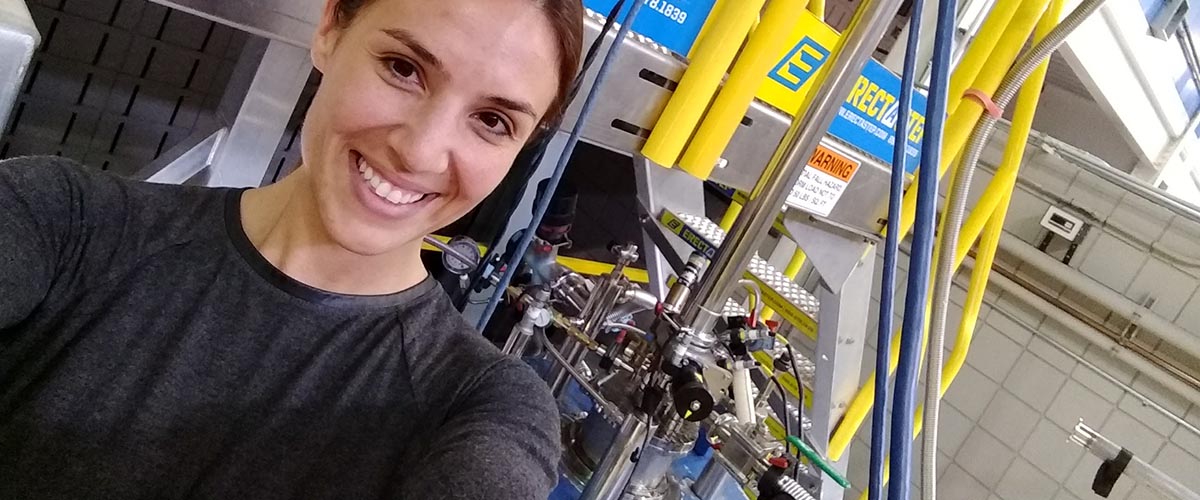
This MagLab user talks about meeting Leonardo da Vinci, making magnetic soup and the freedom of being a scientist.
Kim Modic, a postdoctoral research scientist at the Max Planck Institute for Chemical Physics of Solids, answered some questions after her recent experiment in the MagLab’s DC Field Facility.
What is the official title of your experiment proposal?
Study of the anisotropic magnetic response in the spin-liquid state of RuCl3
Can you please translate that?
We're exploring a new material that is expected to host a new magnetic state of matter, called a spin-liquid. This new state of matter can be thought of analogously to water, but instead of H2O molecules, it's made of disordered magnetic moments that arise from electron spins. This "magnetic soup" is rarely seen in materials because the spins would rather form neat, ordered patterns, such as in the ferromagnet stuck to your refrigerator at home. However, with some careful engineering, the spin-liquid state could be realized in some materials and this would have huge implications for information technology, and may even help with our understanding of superconductivity. We have a unique measurement probe to study the magnetic properties of this new state of matter, but to do so we need to measure it at very low temperatures and in very high magnetic fields.
What was the trickiest part of your experiment at the lab?
The trickiest part of this particular experiment was the samples. A lot of labs make RuCl3 (ruthenium chloride) crystals, but they are difficult samples to work with. It has a layered structure, where the layers can flake off like a Greek pastry. The crystals can easily be damaged or deformed when handled. In this measurement, it was important to know the crystallographics directions with respect to the morphology so that we could correctly align the sample. Each step of this process increases your chances of destroying the sample, so we had to put a lot of care into that side of things.
If you could live a parallel life as a non-scientist, what would you do?
I’ve always wanted to own my own business with my husband. I think it would be a lot of fun to build something from the ground up and watch it grow. If we completely owned something, we could make all the decisions. We would have so much pride in it, as well as a vested interest to turn it into a success! And I know we would be good at it.
What's your motto?
Can't stop — won't stop ☺
How many times have you been a user at the MagLab?
Twice.
What person from history would you love to sit next to on an airplane, and why?
Leonardo da Vinci, because he dabbled in everything and back at that time, there were so many unknowns. It would be interesting to hear how he thought about things and why he had the interests he had.
Why science?
I liked my high school physics class. It was the first time I felt challenged in school and my teacher, Amy Beiter, made it fun.
Coolest thing about the MagLab:
The 45-tesla hybrid magnet — I guess it's a little creepy back there, but definitely cool.
Most memorable experimental moment of your career:
If I have to choose — I would say one week of 100-tesla magnet time at the MagLab's Pulsed Field Facility in Los Alamos, NM. With that magnet, you have one chance to get data every three hours. That’s three (maybe four) pulses a day for one week. You need to choose temperature, orientation, and a million other conditions wisely. We were doing torque magnetometry on an unusually magnetically anisotropic material, and I think we either broke the cantilever or lost the sample between almost every magnet pulse. After every shot, there was complete chaos; pull the probe, unwire the lever, switch the sample, and cool it all back down, in time for the next pulse. It was one of those "never give up" weeks and in the end, we were very successful due to the efforts of so many people. And it was a ton of fun.
What problem do you hope your research will one day help solve?
I guess it could ultimately help solve a variety of important problems. It would be really cool if it's ever even just the tiniest piece of any huge puzzle solved in condensed matter physics.
What do you do to recharge your science batteries?
I like to go to the gym or run outside. I also enjoy walking my dogs. It's a good excuse to step away from work and take your mind off things.
What is the best part about your career?
Having the freedom to work on whatever I want to work on. I like that I can walk away from any one particular project when I get stumped or frustrated and come back to it later. I also really enjoy the variety of tasks that come with the job, such as soldering, wiring, reading, writing, machining, and sample prep, just to name a few. It's impossible to get bored, which makes me very happy!
More than 1,400 scientists come from across the world to use our unique magnets. If you have an experiment you would like to do here, find out how to request magnet time. Magnet time is free.
Last modified on 02 December 2022